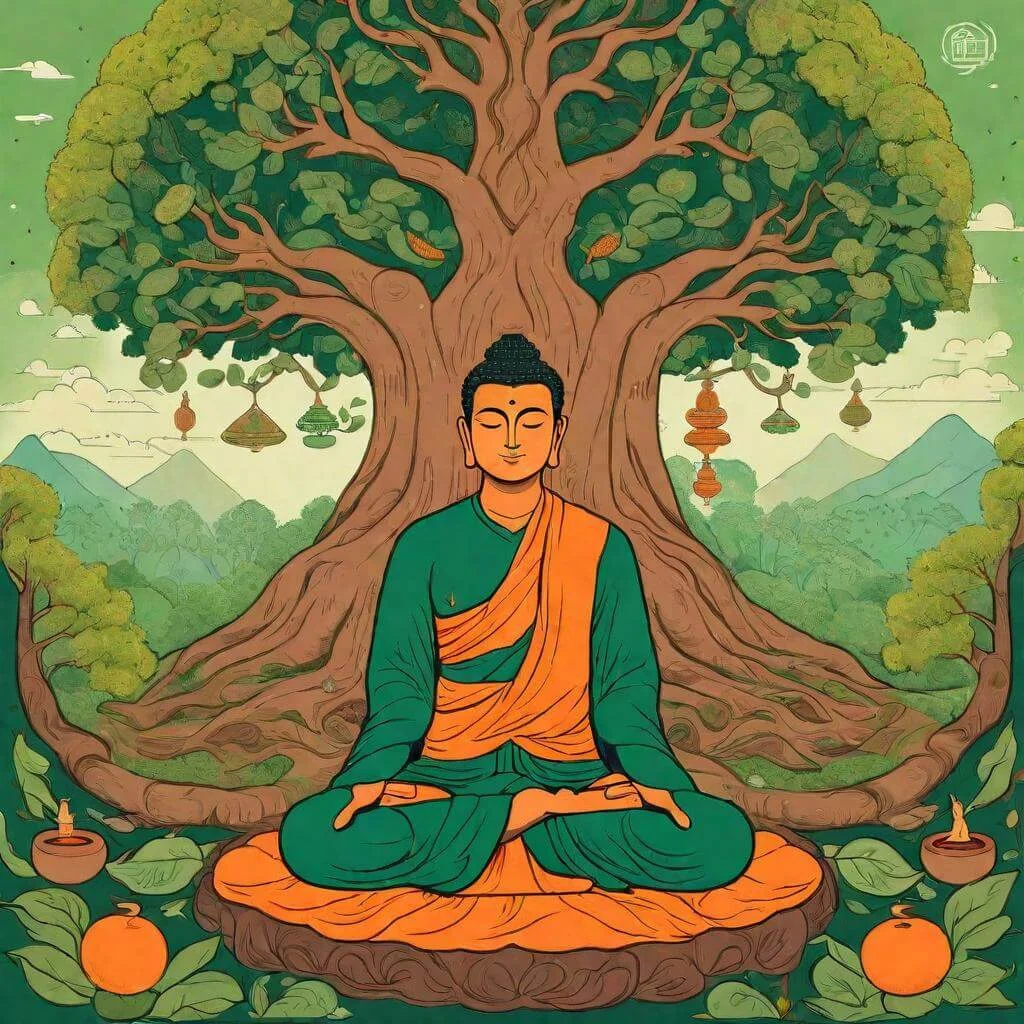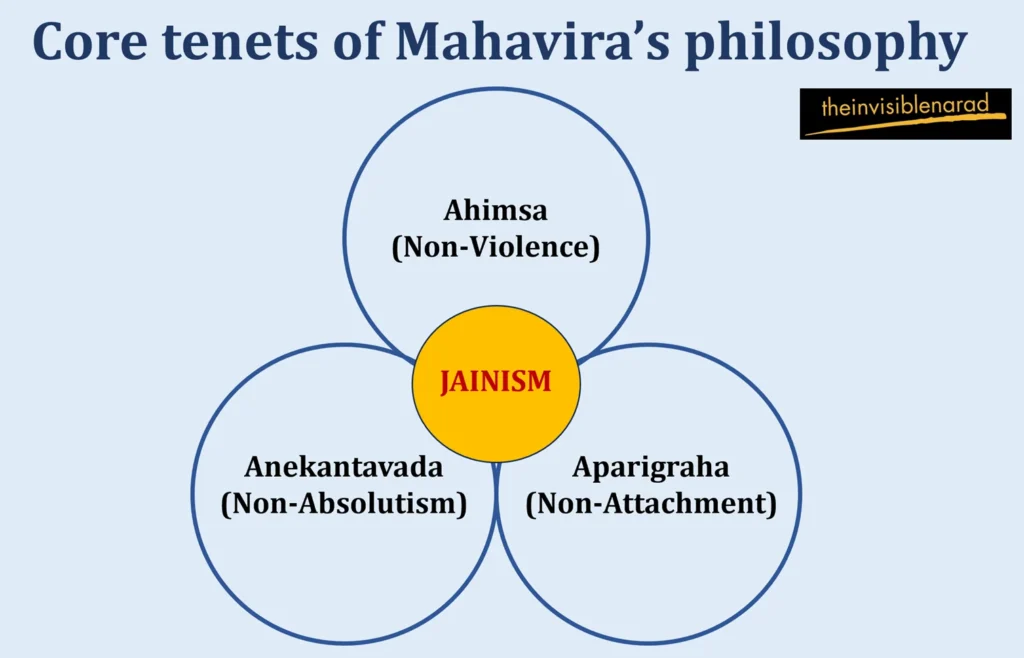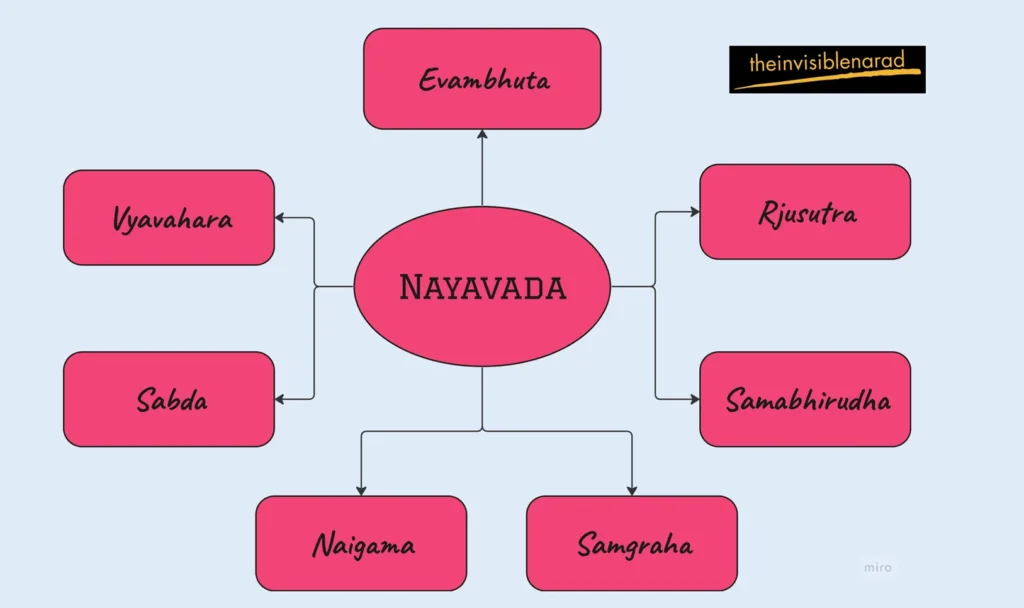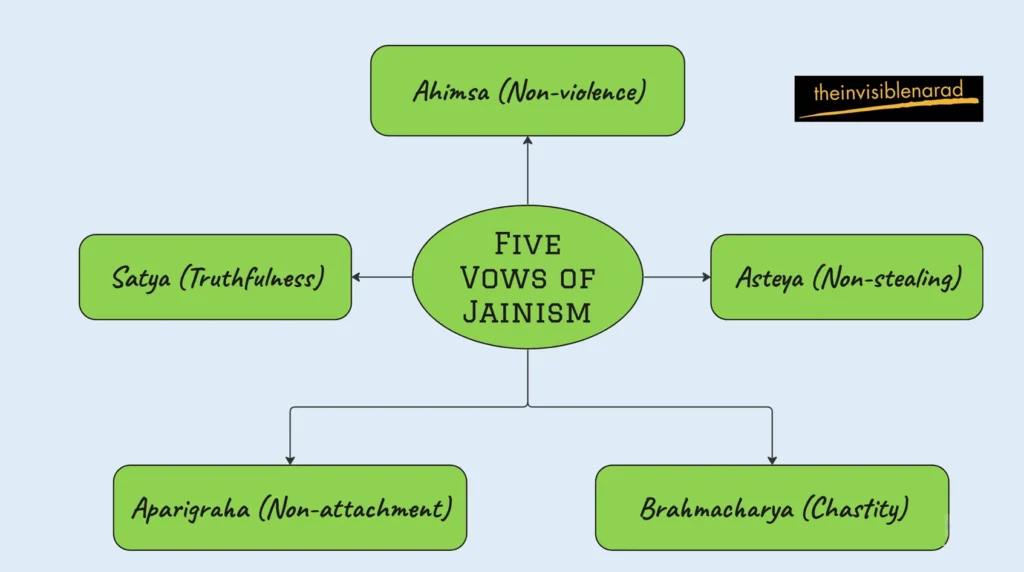
Mahavira, also known as Vardhamana, was a pivotal figure in the development of Jainism, one of the oldest religions in the world. He is revered as the twenty-fourth Tirthankara, or spiritual teacher, in Jain tradition. Mahavira’s teachings emphasize principles such as non-violence (ahimsa), truthfulness (satya), non-possessiveness (aparigraha), and asceticism. His profound insights into the nature of existence and the path to liberation have deeply influenced Jain philosophy and continue to inspire millions of followers worldwide.
In this blog post, we will delve into the life and teachings of Mahavira, exploring the various facets that shaped his spiritual journey and the enduring legacy he left behind.
Early Life and Spiritual Awakening
Birth and Childhood
Mahavira, the revered Tirthankara, descended into the royal lineage of King Siddhartha and Queen Trishala, amidst the splendor of the Ikshvaku Dynasty. The dynasty’s legacy, traced back to the First Tirthankara, Rishabhanatha, imbued his birth with profound significance. In accordance with Jain tradition, the thirteenth day of the rising moon in the month of Chaitra signifies the birth of Mahavira in 599 BCE at a place called Basarh (Vaishali). He was named Vardhamana, which means “One who grows” or “One who prospers,” indicating the high hopes his parents had for him. According to Jain tradition, his birth was accompanied by auspicious signs and celestial omens.

Legend shrouds the exact location of his birthplace, Kshatriyakund, believed to be nestled near the ancient town of Vaishali in present-day Bihar. However, migrations across millennia have obscured its precise coordinates. Mahavira’s journey to enlightenment, as chronicled in Jain scriptures, traversed myriad rebirths, culminating in his manifestation as the 24th Tirthankara.
Accounts of his birth, embellished with divine interventions, narrate the anointment by Indra and the celestial abhisheka on Mount Meru. These tales, revered by Svetambara Jains, enrich temple rituals and festival observances, resonating with the eternal quest for spiritual transcendence.
Mahavira grew up in luxury as a prince. His parents were followers of Parshvanatha, a revered figure in Jainism. There are different beliefs about whether Mahavira married. According to the Digambara tradition, his parents wanted him to marry Yashoda, but he declined. On the other hand, the Svetambara tradition suggests that he married Yashoda when he was young and they had a daughter named Priyadarshana, also known as Anojja.
Quest for Spiritual Enlightenment
Despite the comforts and privileges of his princely life, Vardhamana was deeply troubled by the suffering and impermanence he witnessed in the world around him. This inner turmoil led him on a profound spiritual quest for understanding and liberation from the cycle of birth and death.
Driven by an insatiable thirst for truth and enlightenment, Vardhamana embarked on a rigorous journey of self-discovery and introspection. He sought guidance from spiritual teachers and engaged in intense meditation to unravel the mysteries of existence.
Renunciation of Worldly Pleasures
At the age of thirty, Vardhamana made a momentous decision that altered the course of his life forever. Renouncing his princely status, wealth, and family ties, he embraced the life of an ascetic in pursuit of spiritual realization.
Determined to transcend the shackles of material desires and attachments, Vardhamana adopted a life of extreme austerity and self-discipline. He forsook all worldly possessions, wearing minimal clothing and subsisting on meager offerings from devotees. His unwavering commitment to renunciation and detachment earned him the title of “Mahavira,” meaning “Great Hero” or “Great Soul.”
Influence of Jainism’s Predecessor on Mahavira’s Teachings
Before Mahavira, the spiritual tradition of Jainism was already well-established, with Parshvanatha as its twenty-third Tirthankara. Parshvanatha’s teachings emphasized non-violence, truthfulness, and compassion, laying the foundation for Mahavira’s later elaborations.
While Mahavira inherited many of the fundamental principles of Jainism from Parshvanatha, he expanded and refined the teachings, particularly in the areas of asceticism and spiritual liberation. Mahavira’s profound insights and profound spiritual experiences further enriched the Jain tradition, solidifying his legacy as one of the most revered figures in Jainism.
Asceticism and Austerities
Mahavira’s rigorous ascetic practices and self-mortification

Mahavira’s path to enlightenment was paved with rigorous ascetic practices and profound self-discipline. Renouncing the comforts of princely life, he embarked on a journey of extreme austerity, pushing the limits of physical endurance in pursuit of spiritual awakening. Mahavira subjected himself to intense penances, enduring long periods of fasting, solitary meditation, and self-mortification.
He embraced the life of a wandering ascetic, clad in minimal clothing and subsisting on scant sustenance. Later he even discarded his cloths and remained to be perfectly concentrated. After preaching his message for 30 years Mahavira died in 468 BCE in Pavapuri at the age of 72. His last rights were performed by Mallas. Mallas are also credited for performing the last rights of Gautam Buddha who was contemporary to Mahavira. His unwavering commitment to austerity earned him the epithet of Mahavira, the Great Hero, among his followers.
The transformative impact of asceticism
Mahavira’s ascetic practices were not merely acts of self-denial but profound vehicles for spiritual transformation. Through relentless self-discipline and introspection, he transcended the limitations of the physical realm, attaining profound states of consciousness and enlightenment. Asceticism served as a crucible for purifying the mind, body, and soul, stripping away the layers of ego and desire to reveal the innate divinity within. Mahavira’s unwavering dedication to asceticism exemplifies the transformative power of discipline and self-control in attaining spiritual liberation.
Enlightenment and Philosophy of Mahavira
Mahavira’s attainment of kevala jnana (omniscience)
Mahavira’s spiritual journey culminated after 12 years of rigorous asceticism in the attainment of Kevala Jnana, or omniscience, a state of supreme enlightenment in which he gained profound insight into the nature of reality. Mahavira gained supreme knowledge while meditating under a Sal tree by a river when he was 42 years old. This transcendent realization empowered Mahavira with boundless knowledge and wisdom, enabling him to perceive the intricate interconnectedness of all existence with unparalleled clarity.
Core tenets of Mahavira’s philosophy
- Ahimsa (non-violence): Central to Jainism is the principle of ahimsa, the practice of non-violence towards all living beings. Mahavira preached compassion and empathy, advocating for the avoidance of harm in thought, word, and deed.

- Anekantavada (Non-absolutism): Jain philosophy embraces the concept of anekantavada, which acknowledges the multifaceted nature of truth and reality. According to this doctrine, reality is perceived differently from various perspectives, and absolute truth is beyond human comprehension.
- Aparigraha (non-attachment): Aparigraha teaches the importance of non-attachment and minimalism, emphasizing the detachment from material possessions and worldly desires as a means to spiritual liberation.
Principle of Syadvada
The idea of seeing things in different ways is called Syadvada. It is an important part of Jainism. It means that everything can be understood in many ways. Reality has lots of sides, and we only know some of them. So, when we judge something, we’re only seeing part of the truth. Our judgments are only partly true because they depend on how we look at things.
In Jainism, there are seven types of judgments. Each judgment starts with the word “Syat,” which means “relatively.” This idea is called Syadvada or Saptabhanginaya. Here are the seven types:

- Syadasti: Something is existent from a certain point of view.
- Syannasti: Something is non-existent from a certain point of view.
- Syadasti-nasti: Something is both existent and non-existent from a certain point of view.
- Syadavaktavyam: Something is indescribable from a certain point of view.
- Syadastica avaktavyam: Something is both existent and indescribable from a certain point of view.
- Syannastica avaktavyam: Something is non-existent and indescribable from a certain point of view.
- Syadastica nastica avaktavyam: Something is existent, non-existent, and indescribable from a certain point of view.
Doctrine of Nayavada
In Jain philosophy, there’s a concept called “Nayavada.” This theory says that every idea can be true from a certain point of view. So, no idea is really false. There are two main types of Nayas that help us understand stuff better:
- Dravyarthika Naya: This one deals with the eternal part of something, like its basic nature.
- Paryayarthika Naya: This type is more about the changing part of something, like how it behaves or looks different over time.
Once he was asked whether he is one person or many. He calmly replied to be both. According to him he was only one individual with one perspective but on the other hand there are many ways to perceive him which depends on one’s perception.
There are seven different viewpoints or Nayas to understand stuff better:

- Naigama: It’s about seeing both the similarities and differences in things.
- Samgraha: This view only sees things as similar, not different.
- Vyavahara: It’s all about pointing out the differences, not the similarities.
- Rjusutra: This view just focuses on what’s happening right now, in the present moment.
- Sabda: It’s about how words can mean different things at different times or in different situations.
- Samabhirudha: This one looks at the slight differences in meaning between similar words.
- Evambhuta: It’s about understanding the meaning of a word based only on what someone is doing right now.
Comparisons with Other Contemporary Spiritual Philosophies
Mahavira’s philosophy shares similarities with other contemporary spiritual traditions, such as Buddhism and Hinduism, particularly in their emphasis on compassion, non-violence, and the quest for enlightenment. However, Jainism distinguishes itself through its uncompromising commitment to non-violence and its unique doctrines of Anekantavada and Syadvada, which offer nuanced perspectives on reality and truth. Here’s a comparison between the teachings of Jainism, Buddhism, and Hinduism:
| Jainism | Buddhism | Hinduism | |
|---|---|---|---|
| Views on God | Rejects the concept of a creator God and emphasizes individual effort towards spiritual liberation. | Rejects the existence of God and focuses on the individual’s path to enlightenment. | Believes in a supreme being, Brahman, who manifests in various forms (gods and goddesses). Emphasizes devotion (bhakti) to attain union with Brahman. |
| Concept of Karma | Karma is seen as a subtle material substance that adheres to the soul due to past actions. Liberation (moksha) is achieved by purifying the soul of karma. | Karma is understood as the law of cause and effect, influencing one’s present and future experiences. Liberation (nirvana) is attained by breaking the cycle of karma and rebirth. | Karma is the law of moral causation, determining one’s future existence based on past actions. Liberation (moksha) is achieved by realizing one’s true self (atman) as identical to Brahman, transcending karma. |
| Attitude towards Non-violence | Emphasizes absolute non-violence (ahimsa) towards all living beings. Practitioners strive to avoid harm in thought, word, and deed. | Advocates non-violence and compassion towards all sentient beings. The first precept of Buddhism is to abstain from harming living beings. | Values non-violence (ahimsa) but allows for exceptions in certain circumstances. Ahimsa is one of the key principles of Hindu ethics. |
| Path to Liberation | Liberation (moksha) is achieved through self-discipline, asceticism, and purification of the soul from karma. Liberation entails breaking the cycle of birth and death. | Liberation (nirvana) is attained by following the Eightfold Path, which includes right understanding, intention, speech, action, livelihood, effort, mindfulness, and concentration. | Liberation (moksha) is achieved through various paths, including karma yoga (path of selfless action), bhakti yoga (path of devotion), and jnana yoga (path of knowledge). |
| Views on the Soul | Believes in the existence of an eternal soul (Jiva) that can attain liberation through spiritual practice. | Rejects the concept of a permanent, unchanging soul (anatta). Teaches the doctrine of no-self, emphasizing the impermanent and interdependent nature of existence. | Believes in the existence of an eternal soul (atman) that is identical to Brahman, the supreme reality. Teaches the concept of reincarnation and the cycle of birth and death (samsara). |
While all three religions share some commonalities, such as the emphasis on moral conduct and spiritual growth, they also exhibit distinct philosophical and doctrinal differences shaped by their respective historical contexts and cultural influences.
Founding of Jainism
Philosophy of Jainism
The Major Philosophy of Jainism revolves around the “JINA” or self-conquered Person. Even though Jainism recognizes the existence of God but places it below “JINA”. According to this religion universe is not regulated by any divine authority but through continuous interaction between Biotic Community (JIVA) and Abiotic component (AJIVA). Such philosophy is highly scientific that led to acceptance of Jain faith.
Mahavira also discussed about realization of truth which is not possible through one single approach. There has to be multi-dimensional approach to attain relative truth. This philosophy known as Anekantavada.
Moreover, Mahavira emphasized on attainment of Moksha or salvation to end the cycle of birth and death. This objective can be attained only by an ascetic performing regimented discipline. Tt is believed that a person can attain Kevala with extreme purity and can approach towards Moksha. In order to reduce the gap between Kevala and Moksha, person must try to end his life through self-mortification. This is known as Santhara or Sallekhana.
Concept of Tri Ratan
At the heart of Jainism lies the concept of Tri Ratan, the Three Jewels or Three Gems, which serve as the foundation of the faith. Mahavira advocated these 3 paths to attain Kevala. These are:

- Right Faith (Samyak Darshana): The belief in the fundamental principles of Jainism, including the doctrine of karma, ahimsa (non-violence), and the path to spiritual liberation.
- Right Knowledge (Samyak Jnana): The pursuit and acquisition of true knowledge, leading to an understanding of the nature of reality and the self.
- Right Conduct (Samyak Charitra): The adherence to moral and ethical principles, encompassing compassion, honesty, and non-attachment, in all aspects of life.
These Three Jewels form the cornerstone of Jain belief, guiding followers on the path towards spiritual enlightenment and liberation from the cycle of birth and death.
Beliefs in Karma and Reincarnation
Jainism espouses a profound understanding of karma, the law of cause and effect, which governs the universe. According to Jain doctrine, every action, whether physical, mental, or verbal, generates karma, which binds the soul to the cycle of birth, death, and rebirth. The accumulation of karma influences one’s future experiences and determines the conditions of their subsequent incarnations.
Central to Jain belief is the notion of reincarnation, or the transmigration of the soul through successive lifetimes. Souls, known as jivas, are eternal and undergo an endless cycle of birth and death until they achieve spiritual liberation, or moksha, by breaking free from the karmic cycle.
Five Vows (Five Mahavratas) of Jainism
Based on his teaching as well as the teachings of the earlier twenty-three Trithankaras Mahavira presented Five Vows. The Five Vows, or Five Mahavratas, are fundamental ethical precepts observed by devout Jains as a means of purifying the soul and advancing on the path to spiritual enlightenment. The fifth vow was added by Mahavira, and the remaining were proposed by his predecessors. These vows are:

- Ahimsa (Non-violence): The commitment to non-violence in thought, speech, and action towards all living beings.
- Satya (Truthfulness): The practice of truthfulness in speech and communication, avoiding falsehood and deceit.
- Asteya (Non-stealing): The renunciation of stealing or taking what is not freely given.
- Aparigraha (Non-attachment): The cultivation of non-attachment to material possessions and worldly desires, fostering contentment and detachment.
- Brahmacharya (Chastity): The observance of celibacy or fidelity in marital relationships, promoting spiritual purity and self-control.
Adherence to these Five Vows is considered essential for leading a virtuous and righteous life, and they serve as guiding principles for Jain practitioners in their pursuit of spiritual liberation.
Spread of Jainism and Legacy
Monastic Community (Sangha)
The establishment of a monastic community, known as the Sangha, played a crucial role in the spread and preservation of Jainism. Mahavira initiated the first group of monks, known as sadhus, who dedicated their lives to the pursuit of spiritual realization and the propagation of Jain teachings. The Sangha provided a supportive environment for monks and nuns to engage in rigorous spiritual practices, study scriptures, and disseminate the principles of Jainism to the broader community. Over time, the Sangha expanded, establishing monastic centers and attracting followers from all walks of life, contributing to the enduring legacy of Jainism.
Impact of Jainism on Indian society and culture
Jainism has left an indelible mark on Indian society and culture, influencing various aspects of life including ethics, art, architecture, and literature. The Jain emphasis on non-violence, compassion, and reverence for all life forms has fostered a culture of peace and harmony, promoting tolerance and acceptance within diverse communities. Jain temples, adorned with intricate carvings and architectural marvels, stand as testament to the artistic and spiritual achievements of Jain civilization. Furthermore, Jain literature, including sacred texts and philosophical treatises, continues to inspire scholars and seekers worldwide, enriching the cultural tapestry of humanity.
Relevance of Mahavira’s Principles in the Modern World
In today’s rapidly evolving world, Mahavira’s timeless principles offer invaluable guidance for navigating the complexities of modern life. The Jain emphasis on non-violence, truthfulness, non-attachment, and self-discipline resonates deeply with contemporary concerns such as environmental conservation, social justice, and personal well-being. Mahavira’s teachings inspire individuals to cultivate compassion, mindfulness, and ethical awareness in their interactions with others and the natural world. By embracing Mahavira’s principles, individuals can foster a more sustainable and harmonious society, grounded in respect for all living beings and the pursuit of spiritual enlightenment. Thus, Mahavira’s legacy continues to illuminate the path towards a more compassionate and enlightened world.
Controversies and Misunderstandings
Misconceptions Surrounding Mahavira’s Teachings
Despite Mahavira’s profound wisdom and ethical teachings, misconceptions and misinterpretations have arisen surrounding his philosophy over time. One common misconception is the belief that Jainism advocates extreme asceticism to the point of self-harm. While Mahavira practiced rigorous asceticism as a means of spiritual discipline, Jainism also emphasizes compassion, non-violence, and the well-being of all living beings. Another misconception is that Jainism promotes nihilism or a rejection of the world, whereas in reality, Jainism teaches a profound reverence for life and advocates for responsible stewardship of the environment.
Criticisms of Jainism and Mahavira’s philosophy
Critics of Jainism have often raised concerns about the practicality and feasibility of its ethical principles, particularly the emphasis on non-violence and strict adherence to vegetarianism. Some argue that Jainism’s emphasis on non-violence may be impractical in a world marked by conflict and aggression. However, proponents of Jainism counter that the philosophy of non-violence extends beyond physical actions to encompass thoughts and intentions, offering a transformative approach to resolving conflicts and promoting peace.
Mahavira’s true intentions and the essence of Jainism
To dispel misunderstandings surrounding Mahavira’s teachings, it is essential to clarify his true intentions and the core tenets of Jainism. Mahavira’s teachings are rooted in compassion, non-violence, and the pursuit of spiritual enlightenment for the benefit of all sentient beings. Jainism emphasizes the interconnectedness of all life forms and advocates for ethical living, self-discipline, and inner purification as means of achieving liberation from suffering and the cycle of rebirth. By understanding the essence of Jainism and Mahavira’s teachings, misconceptions can be addressed, and the profound wisdom of this ancient tradition can be appreciated more fully.
Legacy of Vardhaman Mahavir
Impact on Indian Society
Vardhaman Mahavir’s teachings have left an indelible mark on Indian society, shaping its moral and ethical fabric. His emphasis on non-violence, truthfulness, and compassion has influenced countless individuals and communities, fostering a culture of peace, tolerance, and respect for all life forms. Mahavir’s teachings continue to inspire social reform movements and advocacy efforts in areas such as environmental conservation, animal rights, and non-violent resistance.
Jain Festivals and Rituals
Jainism boasts a rich tapestry of festivals and rituals that celebrate the life and teachings of Mahavir and other revered figures. Mahavir Jayanti, commemorating Mahavir’s birth, is celebrated with fervor across Jain communities, marked by prayers, processions, and charitable acts. Other significant festivals include Paryushana, a period of fasting, reflection, and spiritual renewal, and Diwali, which holds special significance for Jains as the day of Mahavir’s nirvana, or liberation.
Modern Jainism and Global Outreach
In the modern era, Jainism has transcended geographical boundaries, with a growing presence and influence on the global stage. Jain communities around the world actively promote the teachings of Mahavir through educational initiatives, interfaith dialogues, and humanitarian projects. Jain principles of non-violence, environmental stewardship, and ethical living resonate with people from diverse backgrounds, contributing to a more compassionate and sustainable world.
Conclusion & FAQs
Vardhaman Mahavir’s life was characterized by a profound commitment to spiritual truth and ethical living. From his renunciation of worldly comforts to his attainment of enlightenment, Mahavir’s journey exemplifies the transformative power of self-discipline and compassion. His legacy as the twenty-fourth Tirthankara continues to inspire millions to lead lives of virtue and spiritual fulfillment.
Mahavira’s philosophy of non-violence, truthfulness, and non-attachment holds timeless relevance in today’s tumultuous world. In a society plagued by conflict, inequality, and environmental degradation, Mahavira’s teachings offer a beacon of hope and guidance, reminding us of the inherent dignity and interconnectedness of all life.
As we reflect on Mahavira’s legacy, let us embrace the invitation to explore Jainism’s profound wisdom and ethical principles. Whether through study, contemplation, or engagement with Jain communities, there is much to learn and appreciate from this ancient tradition. By incorporating Mahavira’s teachings into our lives, we can contribute to a more compassionate, harmonious, and sustainable world for future generations.
Frequently Asked Questions (FAQs)
Who was Mahavira?
Mahavira, also known as Vardhamana, was a spiritual teacher and the twenty-fourth Tirthankara (spiritual leader) of Jainism. He lived in ancient India during the 6th century BCE and is revered as a profound philosopher and ascetic.
What are the main teachings of Mahavira?
Mahavira’s teachings revolve around the principles of ahimsa (non-violence), anekantavada (non-absolutism), and aparigraha (non-attachment). He emphasized the importance of leading a life of truthfulness, compassion, and self-discipline to attain spiritual liberation.
What is the significance of Mahavira’s renunciation?
Mahavira’s renunciation of worldly pleasures symbolizes his commitment to spiritual awakening and detachment from material desires. His renunciation inspired countless followers to pursue a life of austerity and self-discipline in their quest for enlightenment.
How did Mahavira attain enlightenment?
Mahavira attained enlightenment through rigorous ascetic practices, deep meditation, and unwavering determination. After years of intense spiritual striving, he achieved kevala jnana (omniscience) under a sal tree, gaining profound insight into the nature of reality.
What is Mahavira’s role in Jainism?
Mahavira is considered the founder of Jainism in its current form. His teachings and exemplary life serve as the cornerstone of Jain philosophy, inspiring followers to adhere to the principles of non-violence, truthfulness, and compassion.
How did Mahavira contribute to Indian society and culture?
Mahavira’s teachings had a profound impact on Indian society, promoting values of peace, tolerance, and ethical living. His emphasis on non-violence and compassion continues to influence social reform movements and environmental conservation efforts.
What is Mahavira Jayanti?
Mahavira Jayanti is the annual celebration of Mahavira’s birth, observed with prayers, processions, and charitable acts by Jain communities worldwide. It is an occasion to reflect on Mahavira’s teachings and honor his profound spiritual legacy.
What can we learn from Mahavira’s life and teachings?
Mahavira’s life exemplifies the virtues of resilience, compassion, and selflessness. His teachings inspire us to cultivate inner peace, practice non-violence, and live in harmony with all beings, fostering a more compassionate and enlightened world.
